Movie Review – Anatomy Of A Murder
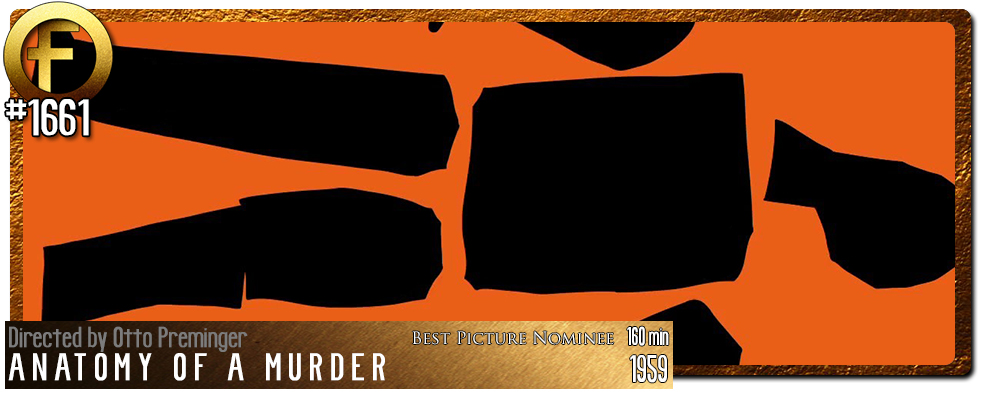
Principal Cast : James Stewart, Lee Remick, Ben Gazzara, Arthur O’Connell, Eve Arden, Kathryn Grant, George C Scott, Orson Bean, Russ Brown, Murray Hamilton, Brooks West, Ken Lynch, John Qualen, Howard McNear, Alexander Campbell, Ned Wever, Jimmy Conlin, Royal Beal.
Synopsis: A hometown lawyer takes on the high profile case of an army man who murders his wife’s rapist.
********
It’s often said that truth is stranger than fiction. Never has that been more prescient than Otto Preminger’s Best Picture-nominated crime drama, Anatomy Of A Murder, a film based on a true-crime case which occurred in the United States state of Michigan in 1952, in which one of the first modern uses of the insanity defence was employed by an accused man’s legal team. Preminger’s film, from a screenplay by Wendell Mayes and based on the novel of the same name, is also an early example of explicit language being used to describe a crime, in this case rape, as well as sexually charged wording and double entendre utilised in depicting the central female character. The film is also noted for its jazzy score by Duke Ellington, and the crisp monochrome photography employed by cinematographer Sam Leavitt (who was Oscar-nominated for his work here).
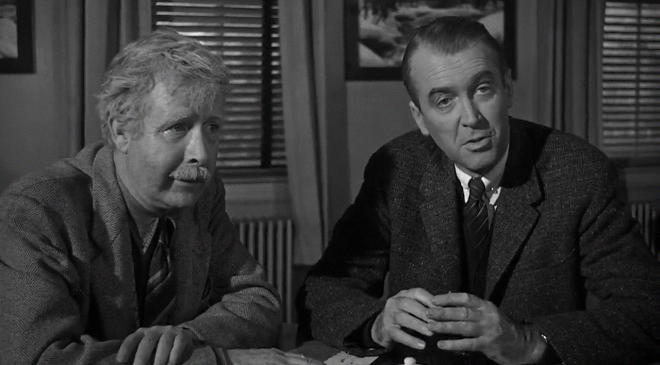
Michigan-born small-town lawyer Paul Biegler (James Stewart) spends his days fishing and losing money, talking law with alcoholic friend Parnell McCarthy (Arthur O’Connell) and avoiding the snark of his secretary Maida (Eve Arden). One day, Beigler is contacted by young wife Laura Manion (Lee Remick), in order that Paul may defend her husband, US Army Lieutenant Fred Mannion (Ben Gazzara), recently imprisoned for killing a local innkeeper. Fred, who does not deny the killing, claims the innkeeper raped his wife. In order to mount a defence, Beigler decides to employ a plea of insanity, an “irresistible impulse” borne of outrage and anger; the court proceedings are run by presiding judge Weaver (Joseph N Welch), and the prosecution team includes Mitch Lodwick (Brooks West) and high-powered attorney Claude Dancer (George C Scott).
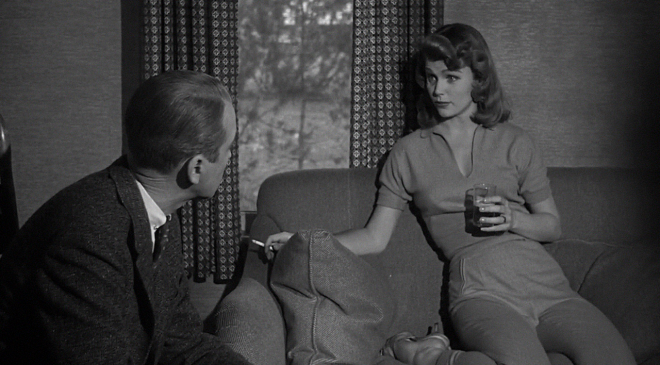
While it spends most of its time embedded within a Michigan courtroom, Anatomy Of A Murder is not the least bit boring or slow. Preminger, a director unafraid of tackling taboo or controversial topics in his film (if you ever get the chance, The Man With The Golden Arm is a genius-level examination of heroin addiction with Frank Sinatra as a druggie), takes on sexual proclivities and rape inside the courtroom in a stark, clinical and methodical crime drama epic that ratchets up tension the longer it progresses. It’s a film of showmanship and exacting execution, a film of intrigue and human violence that doesn’t shy from the grisly or salacious details, a film so controversial in its day it was actually temporarily banned in Chicago.
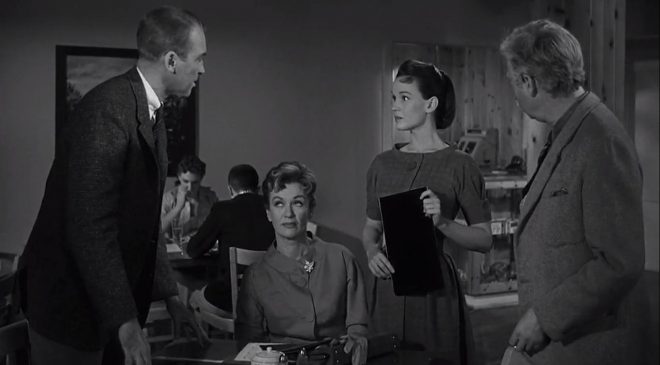
Mayes’ screenplay spends its first act setting up each of the central characters, notably Stewart’s Beigler, Gazzara’s Fred Mannion and Lee Remick’s promiscuously overt Laura Mannion, a woman who is so obviously in love with being the center of attention it causes her husband to snap and actually kill a man. The interplay between all the characters is electrifying, the language employed strongly suggestive (moreso than other films of the period, I think) and ripe with interpretation, Remick’s hedonistic Laura the definitive femme fatale (literally and figuratively) for her flirty, sexual nature. It’s fascinating to watch a story where the premise isn’t a mystery – Mannion admits his guilt in the first twenty minutes – but rather the examination of guilt over emotion, and the use of temporary insanity to prove a man capable of escaping punishment for a crime. It’s the film’s second and third acts that Anatomy Of A Murder hits its stride; the film’s slow build-up of the case details and witness cross examinations begin to shape the story in a manner the viewer can understand and develop investment in. Mayes handles the indelicate details of the case with stark effrontery – the case discusses orgasm and bodily fluid and violence in the act of rape to a degree it’s really rather confronting to hear Jimmy Stewart refer to it at all (imagine Tom Hanks discussing his last sexual encounter in exacting detail… yeah, that.) – but it’s done so clinically the shock rapidly dissipates. It helps that the cast are all superb actors and know how to maximise their time on screen, brief or long, and delivering this kind of charged-up language is why the film found itself nominated for an Oscar.
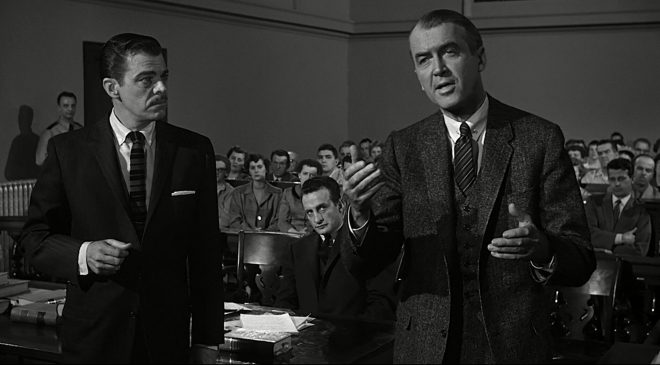
Stewart is commendable in the role of Biegler, it’s the kind of part he could play in his sleep. Dewey eyed about America’s love of its institutions, especially it’s justice system, Stewart’s upright lawyer character is barely a facade for the actor to deliver rousing, impassioned monologues in the vicinity of those seen Mr Smith Goes To Washington. With such a role, it’s little wonder Stewart found himself nominated for a Best Actor Oscar again. His immediate co-stars, Arthur O’Connell and Eve Arden (most will recognise her as the dour school principal in both Grease films), supply solid support in both humour and dramatic elements, as the case becomes far more sensational than anyone expected initially. Remick, as Laura, is suggestive and manipulative and overtly sexual as the character demands, while Ben Gazzara’s Fred is stoic, quietly ferocious and altogether an impenetrable role. One has to keep reminding oneself that Fred is actually a killer, self-admitted, and that he has committed the most heinous of crimes, and is not – as I kept thinking from time to time – the victim. Kathryn Grant, as a young Mary Pilant, a waitress at the inn in which the killing occurred, has a minor but essential role to play in the story, and the actress is equal to the task. Supporting roles to George C Scott, as a high powered lawyer, Russ Brown as a local park caretaker, and Al Paquette, as the inn’s bartender, offer solid work in their respective roles, while special mention should be made of Joseph Welch, who plays the film’s case judge, Judge Weaver: Welch is brilliant as the laconic, sarcastic Judge who suffers no fools gladly but is willing to get to the truth of the case.
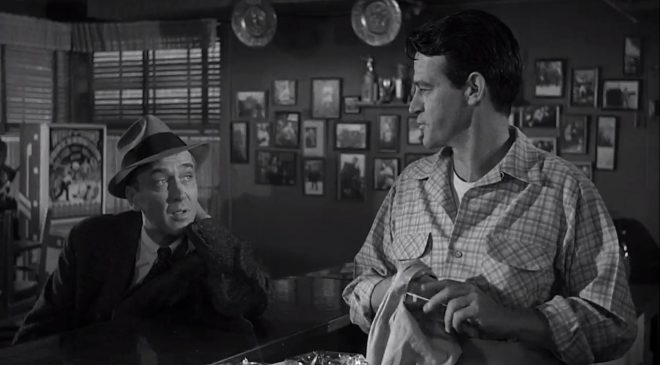
If you’ve never seen a film by Otto Preminger, you really do owe it to yourself to do so. The man can direct a movie, and he does just that with Anatomy Of A Murder. The film is electrifyingly paced, a tension-filled examination of the human condition, and Preminger’s command of the camera and editorial prudence is absolutely first rate. As mentioned, the cinematography by Sam Leavitt is sublime, a masterclass in framing, focus and the use of light and shadow; from the gradually out-of-the-darkness opening involving Stewart’s character returning from a fishing trip to the antiseptic precision of the courtroom, every frame and cut of this film’s lengthy running time pushes the limits of cinematic achievement. For a film set mainly in a single courtroom for the majority of its running time, Preminger executes some daring filmmaking indeed. Now, one of the film’s more acclaimed elements is the Duke Ellington score – Ellington was a legendary musician and composer of significant influence, with a career spanning over fifty years and including a large catalogue of jazz music – and I have to say it left me a little unimpressed. Jazz isn’t my bag, baby, and while I guess the music in this film is attuned to the sultry nature of the premise, it didn’t sit well with me; that’s not to say it’s bad, I just didn’t click with it.
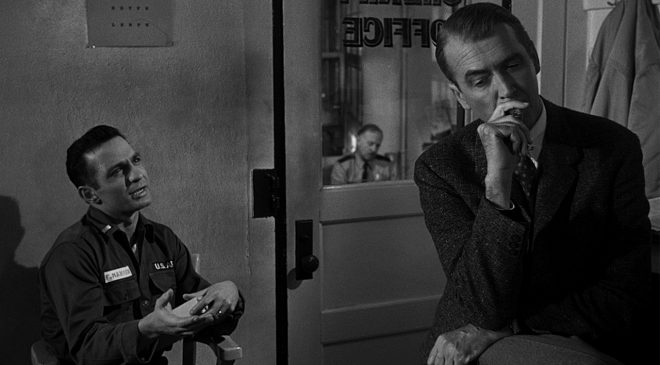
Bold, daring and absolutely riveting the moment we step inside the courtroom, Otto Preminger’s Anatomy of A Murder is sizzling crime drama at its absolute best. Led by Stewart and a cast of impeccably directed performers, with a script that dares you to look away and is absolutely unflinching in its portrayal of both courtroom procedure and the nascent sexual criminality inherent in the plot, Anatomy of A Murder is first class cinema, torn from the headlines and still as white-hot prescient now as it must have been in 1959.

